

In this part of the Company of Heroes 2 “Guides” we will talk about the Germans. This is one of the more favorite factions, and I played it more often myself. However, it is very easy to fail with the Germans, especially if you fail to understand their “system”, or rather, do not take advantage of their strengths and limit their weaknesses. First I will introduce you to the different units for the Germans (mentioning a few of the Special ones) then moving onto some Tips and Strategies, with the Germans.
If you are looking for more info we have a general list of Company of Heroes 2 Guides.
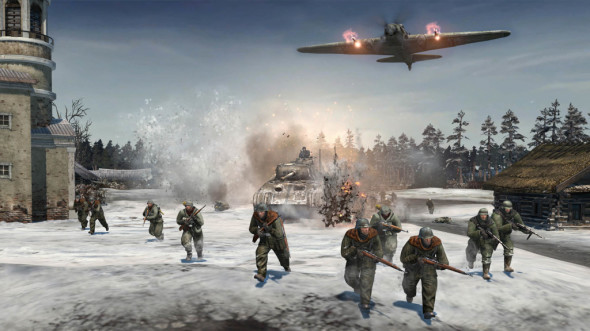
“Forward! For Germany!” (Spoiler: That is not a German plane above them.)
The Germans in Company of Heroes 2 are mainly composed of higher quality and more expensive troops. However, the higher quality does not necessarily translate into versatility, nor does it guarantee automatic “wins”. Playing as the Germans calls for carefully using your troops, and not sacrificing them needlessly, especially any Armor that you might had produced. It is very easy to get carried away with your first Panzer IV and send it straight into a cross-fire of one or two ZiS-3s. The key to being a competent German commander is to play it safe. That is not to safe that you should not take risks, but all German units are expensive, and losing your equipment to Soviet troops, who might then use it themselves, will pose a great threat to your own troops.
The Germans have some substantial strengths and weaknesses, in the different unit types, and later on I will discuss them. First, I would like to speak of the Core German units that every commander will have access to. I will mention some of the Special Units, but at the end of the day you can win a game using only your core units.

Pioneers fighting against Conscripts over an Ammo Point. The Pioneers cannot win, but at least they can stall the conscripts until help arrives.
Pioneers – The German Pioneer is very similar in stats and combat effectiveness to the Combat Engineer from the Soviets. This four man squad is equipped with MP-40s, and as such is more effective at close range, if you want to use them for combat. Do not assume the the Pioneers are a sensible combat unit choice. The Pioneers cost almost as much as the Grenadiers, and the Grenadiers, unlike the Pioneers, can deal with most early Soviet Infantry units. Pioneers may be equipped with a flamethrower or “De-Wiring” equipment, which allows them to either act together with the main attack force, to clear out enemy HMG, Anti-Tank Guns and Mortar Emplacements, as well as fortified buildings, or to clear out enemy minefields and defenses.
The Pioneer’s main task, however, is to build and repair. Pioneers can construct all the necessary base buildings and upgrade neutral resource points to produce additional fuel or ammo. At the same time, Pioneers can lay down solid anti-tank and anti-infantry mines, as well as construct bunkers, that can be upgraded to host an HMG, Medical Bunker or Command Outpost. In other words, the Pioneers are an essential support unit to maintain your base, front and most importantly tanks and vehicles. No other unit is capable of vehicle repairs so you will need a few crews of Pioneers, later on in the game.

A squad of Grenadiers trying to stay warm while protecting a Victory Point. (HMG hidden in the tower behind them)
Grenadiers – The Core of the German Infantry, Grenadiers are armed with rifles and may be upgraded to use an LMG. The Grenadiers are long-distance fighters, which makes them excellent on the defense. They can be put into buildings, bunkers or trenches, thus allowing them to fire volleys into the unprepared Soviet Infantry. In a 1 vs 1 fight Grenadiers can normally beat Conscripts, without either side using their special abilities. Against more elite troops the Grenadiers can still perform adequately making them the basic infantry type for your army.
Grenadiers have the Panzerfaust and Rifle Grenade Special Abilities. The Panzerfaust is a mildly expensive method of protecting yourself from enemy vehicles and tanks. A single Panzerfaust cannot destroy any vehicle or tank, so you might be forced to spend a lot of Ammo on a single target. The Panzerfaust is better used as a support ability, if Paks or Panzer Grenadiers are occupied with bigger targets, and there are lighter vehicles circling among your troops.
The Rifle Grenade is a rather mediocre Anti-Infantry weapon. It can be fired over obstacles and it is surprisingly effective against targets in buildings. However, a 0 Rank Grenadier squad using a Rifle Grenade will usually not cause much damage on an enemy squad. You can still choose to use it on important enemy targets, such as HMGs or Mortars, or troops hiding in buildings.
Lastly, the Grenadiers can also build bunkers, like the Pioneers. This allows Grenadiers to move the Front line forward, and reinforce it. They can also light Fires on Winter Maps, so Grenadiers become essential when creating, maintaining or reinforcing your front. However, Grenadiers cannot repair structures they build, so Pioneers will still be needed. However, Grenadiers can help Pioneers in building Bunkers, and vice versa, speeding up construction greatly.
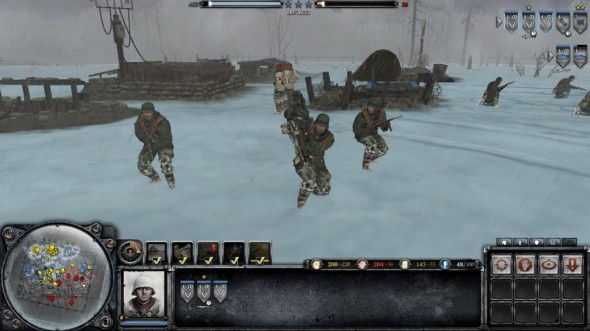
An MG-42 team waiting at base for a Blizzard to pass. If I had a half-track I could move them to the front safely.
MG-42 – The German HMG is a weapon to be reckoned with. A single burst will pin an enemy, and within two or three bursts an enemy will be unable to move away from its fire, forcing them to flee or endure its fire. The MG-42 can also use incendiary special rounds, which make it more deadly against lighter vehicles.
In general, the MG-42 is an essential defensive unit, capable of stalling an entire enemy advance. On the attack it can also be used to force enemy units to flee, or into hiding, allowing your own infantry to advance.
The greatest weakness of the MG-42 is its limited crew size. Two teams of Snipers, or even a single sniper team, can take out an MG-42 crew, if you do not pay any attention to it. Enemy artillery fire and tanks can also kill the crew before they have a chance to flee. Keeping the MG-42 in green cover will allow them to survive for much longer.
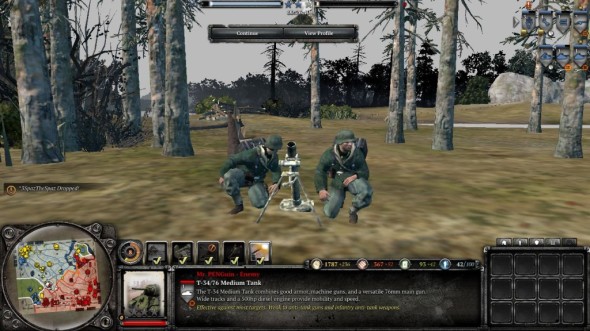
A German Mortar Team (after a won game) still looking behind them to check for flanking enemies.
Mortar – The German (and Soviet) Mortars have a very long range, and are capable of counter-artillery fire. The German Mortar is most effective against enemy weapon teams (HMGs, Anti-Tank Guns, Mortars) but they can also effectively deal with infantry in tight clusters. The Mortar best works together with an HMG, which will pin the enemy to the ground, making them an easier target for the mortar. Mortars may also be used against enemy vehicles but they do not excel in this role, and more often than not they will perform only accidental vehicle kills.
The German Mortar suffers the same problem the MG-42 faces, a very small crew. Snipers and light Soviet vehicles could ambush your Mortars, destroying them before they have a chance to flee. It might be safer to keep your mortars further back, since their range is long enough to still help your front line, but you must keep a wary eye on any fog of war, where enemy vehicles and infantry could be hiding.
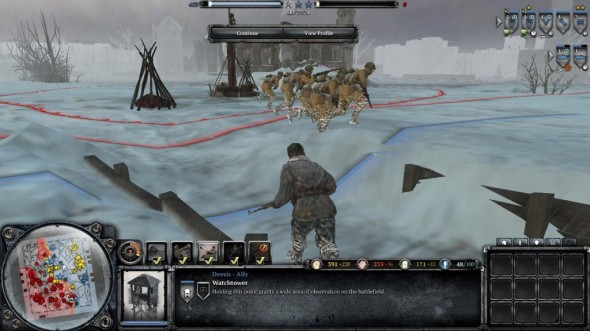
German Sniper sneaking behind a mass of Soviet Infantry.
Sniper – The German Sniper is a single soldier, armed with an accurate and deadly rifle. The problem with the German Sniper is that he lacks the “firepower” of the Soviet Sniper Teams. This is because Soviet Snipers come in pairs. So, an accurate Soviet Sniper Team can take out a Mortar with two simultaneous shots, while a German sniper would need five. That does not mean that the German Sniper cannot help at the front. His long vision and accuracy can still help during a defense or attack, when an enemy could be hiding inside a building, or when you have to finish off an ATG for your tanks to roll through. The problem with the German Sniper is the high cost and limited “use”. An HMG that costs less could pin down an enemy squad, while a Sniper can at best hope to take out the whole enemy squad, which would take a long while.
However, the Sniper can also act as an early spotter for your team. While he is in cover he will be hidden from the enemy, unless they approach too close. So, you can use him to ambush enemy Mortars/Weapon Teams and as a “Scout” or “Spotter” for enemy defenses and attack groups. There might be far cheaper options however so use the Sniper as you see fit.
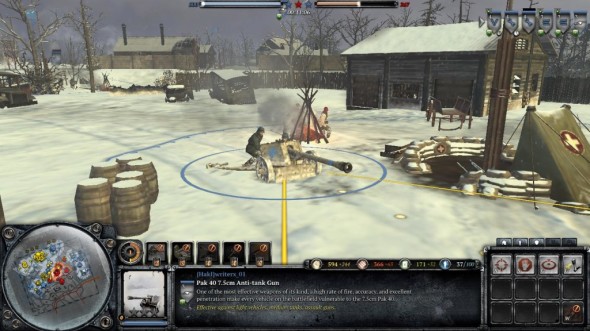
A Pak 40 positioned next to a captured Health Point.
Pak 40- The German Anti-Tank gun is highly effective against enemy Vehicles and Tanks. Based on personal experience I would say that the Pak 40 has the firepower of the Panzer IV, while lacking the mobility and protection. The small crew size makes it very vulnerable to flamethrowers, grenades, molotovs and even enemy tanks, that might flank it.
The Pak 40 should be deployed behind your front line, because of its long range, and best used on the enemy flanks. While it can deal with Soviet tanks from the front far heavier tanks, like the IS-2 and KV-8, could shrug off your fire. In turn, most Half-tracks and the T-70 will be very threatened by the Pak 40.
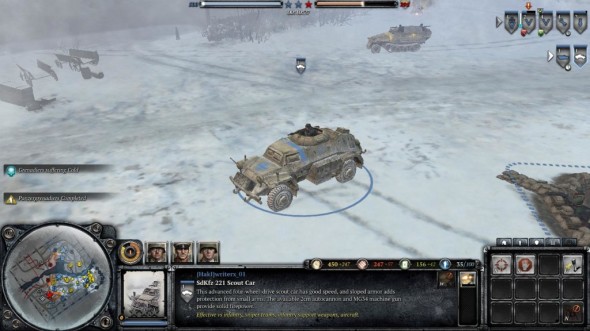
An Armored Car. While it does have limited usefulness it can still perform well when hunting Weapon Teams or Snipers.
Armored Car – This is the cheapest Vehicle at your disposal. The Armored Car is equipped, at first, with an MG and may be upgraded to have a 2cm cannon (this costs 70 ammo however). With the basic MG the Armored Car may be used on single enemy squads, and gun crews (even Anti-Tank Guns), as long as it can outrun their turning. The 2cm cannon, although expensive, can be used to more effectively deal with enemy infantry, but more important it may be used as a counter to early Soviet Half-track rushes, since the 2cm cannon can destroy them quickly. It can even destroy the SU-76, if it manages to circle it. The key to winning with the Armored Car is NOT getting hit.
The Armored Car does become obsolete very quickly however, because it lacks almost any armor, and a single ZiS-3 shot can take it out. As such the Armored Car should not be used once the Soviets deploy heavier vehicles or ZiS-3 guns, since you will waste ammo, fuel and manpower on a unit that cannot deal with late-game pressure.
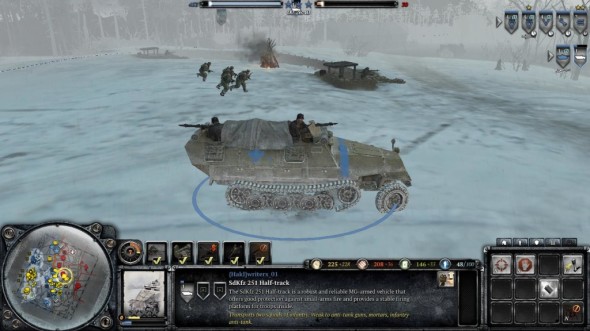
A Damaged Half-Track awaiting repairs. You can clearly see both MG gunners.
Halftrack- The German Half-track may be upgraded to use two very deadly flamethrowers. These flamethrowers work independently of each other, so if the Half-track will have numerous units on both of its sides it can attack different units, in both directions. However, anti-tank weapons can quickly take out a half-track, so it should be used as a support vehicle, in this role, rather than form the spearhead of the attack.
In its basic, unupgraded, form the Half-track can transport two Infantry Units, and is equipped with two Machine guns, one on the front and one on the back. It is not the most powerful Anti-Infantry weapon, but because it can transport units safely and reinforce them (like base structures or Command Outposts) it could be an essential addition to your front line force. It’s lack of a strong weapon and armor should be taken to heart however, so do not waste your resources by throwing your Half-tracks alone into the fight.
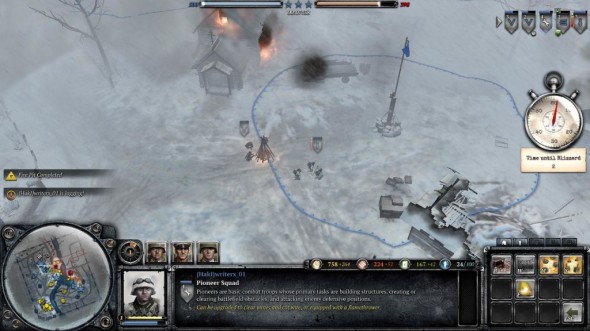
Panzer Grenadiers attempting to push back a mass of Soviet Infantry, with an HMG supporting.
Panzer Grenadiers – Panzer Grenadiers are an improvement to the Grenadier, in a number of ways. They may be equipped with Panzerschrecks, making them very deadly Tank Hunters (if expensive). Their Bundled Grenade can absolutely murder Soviet Infantry, and their Assault Rifles, when used up close, can shred most Soviet Infantry very quickly. However, unlike Grenadiers, Panzer Grenadiers cannot construct bunkers or Fires, so they are better used in an offensive, rather than defensive role. At the same time Panzer Grenadiers are more expensive, so you have to be careful when sending them to the front alone.
Use Panzer Grenadiers to overwhelm enemy positions, together with tanks or other supporting units. They can deal with enemy Tank Hunters quickly, allowing your tanks to push forward. The Panzerschrecks when used by two squads, can force any enemy tank to rethink its advance, although much heavier tanks (like the KV-8 or IS-2) might be much less impressed.
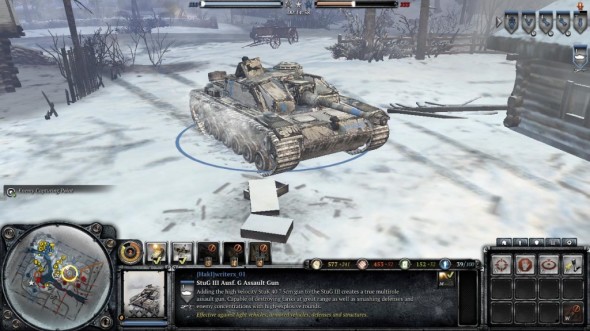
A Stug III on a Winter Map. Note the Top Gunner, who was added to the Stug through an upgrade.
Stug III – This is your only Core Tank Hunter. It is cheap but only half-decent. The Pak 40 can do more damage than the Stug III, however, the Stug has Anti-Infantry capabilities and it can deal mildly well with enemy lighter tanks and vehicles. It can even engage enemy T-34s, but make sure that you do so from the flank, and never the front. In a 1 vs 1 situation the Stug III will normally lose to a T-34.
It is a mobile Tank Hunter, and as such it becomes useful when on the attack. On the defense it lacks the true firepower of the Pak 40. While it is cheaper than the Panzer IV it is not nearly as good. You should by no means consider it an equal to the SU-85 or even the SU-76. Although the SU-76 has less armor it can be used as an artillery gun, so the Stug III can at best be used as a support vehicle to a bigger attack, most likely unable to lead an attack of its own.
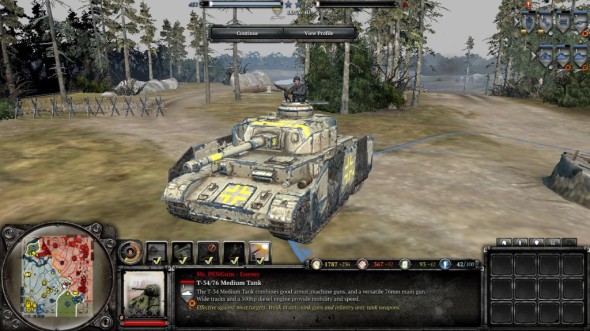
A veteran Panzer IV with Side and Turret Skirts. These will allow the Panzer IV to survive more shots (though I am not certain whether they increase Armor or Health or both).
Panzer IV – The Panzer IV is your “main” Battle Tank. Of course, the Panther is superior to the Panzer IV, but in terms of ease of production and access the Panzer IV will be your main choice of Tank, especially when you prefer quantity over quality (although it is not such a high drop in quality). The Panzer IV, with an upgraded Turret, will have a total of three Machine guns and a mildly powerful main gun. The Panzer IV with its mix of different types of firepower performs very well against most Soviet forces, with the clear exception of the ZiS-3 and SU-85, which can pierce its front hull easily.
The Panzer IV is mildly tough, especially from the front. It’s sides and rear are weak, and any anti-tank weapon can abuse the Panzer IV from these directions. The only exception are the Guards, whose Anti-Tank Rifles will chip away only bits of its hull. It’s main gun is effective both against Armor and Infantry. Heavy tanks will be more resistant to the Panzer IV, but the SU-85 and T-34 both may be defeated by a well controlled Panzer IV.
The Panzer IV best works in groups. Having anywhere between three and five Panzer Ivs will pose a serious threat to any Soviet force. This is of course a huge investment, but if you manage to Vet and maintain your tanks they will become very formidable weapons. After Vet 2 Panzer Ivs will be granted Armored Skirts, and by Vet 3 I observed that even an SU-85 attacking the Panzer IV from the front cannot win.
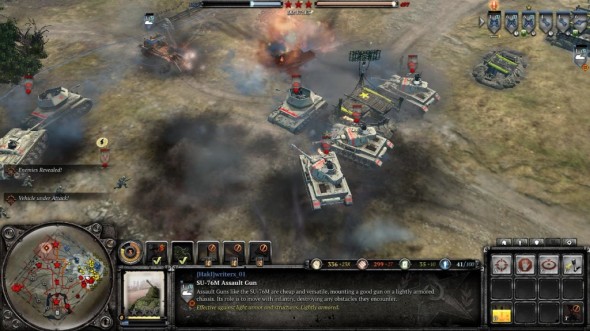
Flakpanzers and Panzer IVs overruning our base completely.
Flakpanzer – I am certain you still remember the Armored Car? Now imagine you took an Anti-Aircraft gun, put it on a Panzer IV and deploy it. The Flakpanzer shares the toughness of the Panzer IV, and uses a powerful anti-aircraft gun, that will not only absolutely annihilate infantry but also take out lightly armored targets with extreme ease. However, because it lacks a more powerful gun it cannot deal with enemy tanks. It’s sides and rear are still vulnerable to anti-tank weapons. In summary it is a very good anti-infantry support weapon with a highly mobile force. It may be used on the defensive role, but an HMG might be more useful, because it can pin enemy squads.

A Panzerwerfer. While it might have an MG top gunner do not expect it to hold any ground on its own.
Panzerwerfer – I would like to insert a very long sigh here. The German Rocket Artillery, in terms of damage per hit, is as powerful as the Katyusha. HOWEVER, the Katyusha, when ordered to fire at a position, will fire three Salvos. The Panzerwerfer will fire only once. In that sense a single Katyusha can heavily damage an enemy position, while the Panzerwerfer will only “scratch the surface”. Do not be mistaken. Rocket Artillery, when it hits enemy tanks directly, can even destroy them. Lighter Vehicles will have a hard time surviving a direct salvo. As such, the Panzerwerfer, while inferior to the Katyusha in terms of “Salvo Length” can still target enemy concentrations and take them out.
The Panzerwerfer, despite looking armored, is in fact very weak. Even a mass of rifles and machine guns could destroy it, not mentioning tanks or anti-tank guns. Keep them safely away from the front line, and move them often to avoid enemy counter-artillery fire.
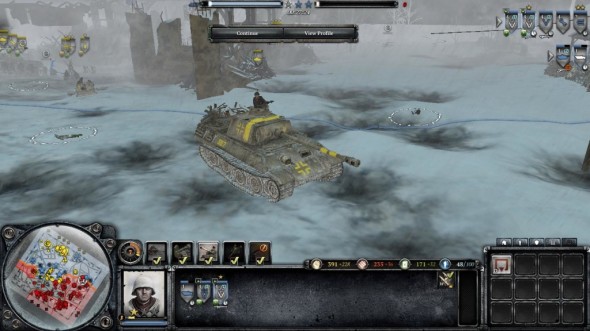
The mighty Panther. It’s front sloped armor poses a true challenge to most Anti-Tank weapons.
Panther – It is tempting to say that the Panther is the most powerful Medium Tank in the game. Sometimes it might even be considered a Heavy Tank.This is something the Soviets lack, and the Germans can brag about, a meaningful Medium Tank. However, the Panther is one of the most expensive core units in the game. It’s loss will cost you heavily in manpower, but it may absolutely empty out your fuel reserves. As such, you must be VERY careful with your Panther. It is not a tank that can go into battle on its own, since a ZiS-3 or Su-85 could easily ambush and take it out, in conjunction with a Guards unit that would Button it.
I could even argue that the Panther is, primarily, a tank meant for tank warfare. While it also has three machine guns its main gun appears to be better suited against armored targets than infantry. Despite having a very solid front it lacks in side and rear armor, so you MUST secure your flanks when using your Panther, and you must be aware of T-34s. Think about it this way, a T-34, that costs around half of what the Panther does, can smash into your panther (using Ramming Speed) and disable not only your Main Gun but also engine. Your super expensive and powerful tank just became a sitting duck. Thus, in an open battle, three Panthers will lose to six T-34s, if you do not protect yourself from their Ramming Speed Ability. Even SU-85s could destroy your Panthers, if you do not pay careful attention to your surroundings.
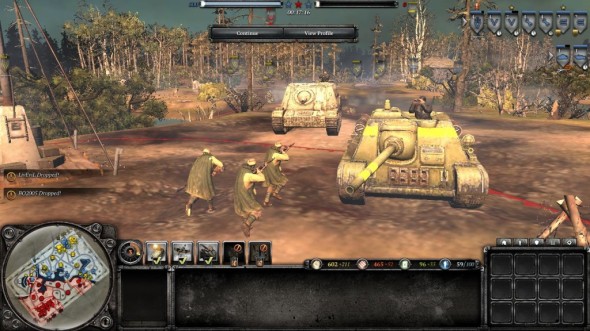
A Brumbar about to teach a squad of Guardsmen what humility means. Take note of the captured SU-85 right next to it.
Brumbar – Somebody got a bit bored, took a massiv armored body and put a gigantic gun on it, you have the Brumbar. The Brumbar is one of the least used support tanks in the game, because it has very limited usefulness. The Brumbar was created to get rid of structures. Unless a map has a lot of buildings that can be fortified, or if the Soviets create highly static positions, the Brumbar does not become overly useful. You can use it against masses of Infantry and Tanks, but it is also a very expensive tank, and you might be better off buying a few Paks, a Panzer IV or Panther, instead of the Brumbar. However, if the enemy is careless, and charges at the Brumbar en-mass with Infantry (as Russians tend to do) the Brumbar could take out a few enemy soldiers with each shot. Still, in order to make it worth its money it would have to kill a decent number of enemy troops, considering it costs a whooping 180 Fuel.

It is still very early into the game and I have a very limited number of troops at the front. On top of that a Blizzard is coming. If you play your cards wrong at the start of the game you could very well lose it all.
Below are some of the Special Units I had the opportunity of playing with, and my thoughts on them. These are normally only available through Commander Abilities, and cannot be ordered to the field in any other way.
Command Tank – The Command Tank is a Panzer IV with only two machine guns and a “Stubby” Main Gun. In simple terms, the Command tank is inferior, in combat, to the Panzer IV, both against infantry and tanks. It’s main purpose is to provide “buffs” to units in the same territory it is. However, the Command tank only provides these bonuses if both it and friendly units (Infantry and Tanks) are present in the same zone, controlled by your team. In that sense the Command Tank is, mainly, a Defensive unit, since it cannot help in the attack with any specific ability. It does not even have to take part in the combat itself. With its higher cost, and weaker combat abilities you should use it in the Support Role, rather than the Spearhead.
Elefant – The Soviet SU-85 feels inadequate all of a sudden… Well, alright, not exactly. The Elefant is a very powerful Tank Hunter. It is tough, it is strong and it is very, very dangerous. Unfortunately, it is not indestructible, and it is very big. In short, it might be big, but it’s also a big target. Furthermore, as I had the pleasure to discover when playing as the Soviets, a single T-34, slamming into the Elefant with Ramming Speed will disable its gun and engine. Since it lacks the machine gun power of other tanks it becomes almost completely defenseless. As such, keep it further back, and only deploy it to the front when it is necessary.
Artillery – German Artillery is very similar to the Soviet Howitzer. It’s big and it shoots over very long distances. Two artillery guns are normally enough to make any Soviet Commander turn around and flee. Even though they cannot move you can deploy them all the way back in your base and they will still be able to fire at the front line. At the same time direct hits from your Artillery guns can take out enemy tanks of any type. The enemy might have time to flee, but they will still be damaged.
Mortar Half-track – The Mortar Half-track is better protected than your ordinary Mortar Crew, and it can use Incendiary Mortar rounds, making the battlefield a very dangerous place for enemy infantry. It is not that expensive, and with the added mobility and protection (as well as the long firing range) you can safely bomb the enemy and change your position, instantly.
“Eastern Troops” – Ostruppen may be obtained through the use of Relief Infantry ability. Up to six infantry squads that die while the ability is active will be exchanged for Ostruppen. On one hand you might think, “Yay! Fresh troops!” while in fact you should be asking yourself the question, “WHY?!”. Ostruppen are very weak. They appear to be closer to the level of Grenadiers than Pioneers, but they are by no means good. They lack any special abilities and have no upgrades. In other words, you just spent 200 Ammo to obtain 0-6 below-average infantry squads. To be honest, I only used the ability once, and in order for it to pay-off I had to sacrifice three of my Grenadier squads.
In the end, why would you ever use this ability/get these troops? The option does exist that you are getting butchered, and you have a surplus of ammo, that happens. You may obtain a few Ostruppen squads, and then use them to man HMGs, Pak 40s or Mortars, perhaps fortify some structures or send them as aid to your allies. The 200 Ammo could be used in better ways though, such as using Sector Artillery (if you have enough CPs to use it). The single Sector Artillery could kill way more enemies than the Ostruppen ever could, especially if it is tanks we are talking about.
Now comes the, somewhat, most difficult part of this Guide, the list of different Strategies, observations and “tests” I made in order to allow you to analyze for yourself, and thus better benefit you when you play as the Germans. While I will not be able to tell you absolutely everything I hope you will still be able to learn something from it.
When you first begin your battle a lot of people would say that your initial choice of troops is the most important element of any game. After all, it will influence what are your starting positions, and whether you can hold them. What i normally do, with the Germans is build units in the following order: Grenadiers, HMG, Grenadiers. Then, depending on the map and overall situation I might build a Mortar, but I will only deploy the Mortar to the area where the HMG is present. Mortars on their own will not be able to stop enemy troops, and they need to work together with an HMG to be fully effective.
When it comes to moving troops I normally send the Grenadiers and any support teams to the front straight away. Once the Pioneers built the basic Infantry Building in the base they will capture the basic resource points behind the front line, while the Grenadiers/HMG secure the front and hold it. On the “Micro” level I usually try to put my troops slightly “ahead” of the point I am capturing, to negate the enemy any movement into the point. Furthermore, if there is a crucial VP or Fuel Point I will have a Grenadier Squad up front, and then the HMG some distance back. This is so that the enemy will not see the HMG straight away, and once I start pulling my Grenadiers back the enemy might just fall into the HMG fire. Since it takes only two bursts to completely pin the enemy my Grenadiers can then try to finish the enemy off.
The use of buildings is also important, since they can provide even better cover than solid green cover. However, I usually hide the HMG in buildings overlooking the points I am holding (or putting them in green cover). I will put Grenadiers into buildings only when it is apparent that there are a lot of buildings in the area, and if I do not capture and fortify them then the enemy could, and during the early game I might not have the resources to purchase a flamethrower to force them out.
Sometimes if a position was clearly “held”, and the enemy was unable to force me off it I would construct a Medical Bunker. This is for one simple reason, if the enemy managed to wound my troops I might have to send them back to base to recover. With a Medical Bunker near the front I can heal my troops fully and then send them back to their positions. Speaking of which, never send all your troops to heal, at the same time. Somebody should always stay at the front and keep watch. If you leave the front undefended enemy troops could take your positions, leaving you at a disadvantage.
Command Outposts might also be useful, and there is no reason why you should not build HMG bunkers to cover your flanks, however, the more bunkers you build the more defensively you play. The resources you invest in bunkers and upgrades could be used on troops and their own upgrades (such as LMGs for Grenadiers). If you manage to route the enemy “starting” force you should try to send your grenadiers and pioneers to capture some enemy territory. This will act as a distraction for the enemy, and it will also give you a clear warning of when the enemy is advancing.
Now, after some time you will have two choices, when it comes to “Anti-Vehicle” tactics. Panzer greandiers are the most expensive option, both in terms of manpower and ammo. Their Panzerschrecks will be deadly against most tanks and vehicles, and since they can move rapidly you could take out enemy units from the safety of green cover. However, Panzer grenadiers might be lost quickly to enemy artillery/mass unit tactics, so be sure to pull them back if things get bad. Your second option is the Pak 40. In some ways this is “Overkill”, against early enemy vehicles, but Overkill might be just the thing you need. The problem is that most maps are so open that you would need at least two Paks to watch an area fully, so if you do decide to use a Pak you must put Grenadiers further toward the enemy, so that you can react early enough and reposition your Pak where it is needed. The middle “ground” or perhaps the cheapest option out of all these is the Armored Car. It costs only 80 Manpower and 20 Fuel and its 2cm Cannon upgrade costs 70 Ammo. It is a weakly armored and has little health but the 2cm cannon can destroy Infantry (if used safely from medium distance) and it most certainly can shoot down enemy light vehicles, such as half-tracks and the SU-76. The problem with the Armored Car is that it is very easy to destroy, so you have to use it very carefully, and repair it as soon as it gets damaged.
Out of those three options the Panzer Grenadiers and the Pak 40 will be useful in the more distant future when the enemy deploys tanks or the SU-85. However, if you need a somewhat cheaper alternative, or if the enemy is heavily abusing Snipers, then the Armored Car is the more sensible option (one time an enemy deployed 3 Sniper Squads to haunt my HMGs and Grenadiers. A single Armored Car kept them at bay for most of the battle).
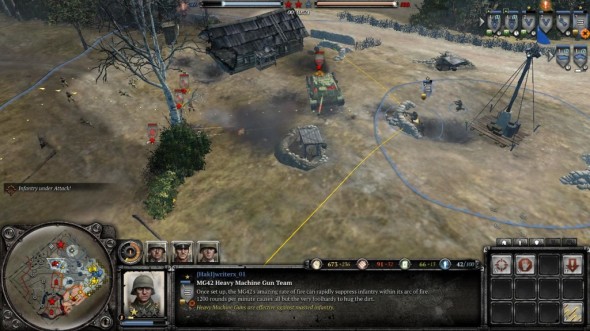
A single HMG managed to stall an entire Infantry advance. It did not stop the SU-85 but it is earning my team enough time to gather a quick counter to this attack.
It is likely that eventually the enemy will use Katyushas and/or Spam Tactics of Infantry or Tanks. Infantry is mildly easy to counter, if you have at least one HMG and mortars. Katyushas are lightly armored, and as such you could send a Panzer IV, Panzer Grenadier Squad or an Armored Car behind enemy lines to hunt down the Katyushas. Katyushas cost a lot of resources, so taking them out will put a huge dent in the enemy economy and force, so even sacrificing a cheaper unit to destroy them would be a huge benefit to you.
The greatest challenge you can face is when the enemy spams Armored vehicles, such as T-34s or SU-85s. The SU-85 is especially dangerous due to its firepower, but it lacks a proper weapon against Infantry. Part of the solution could be to use Panzergrenadiers with Panzerschrecks, but this is very expensive. Pak 40s are less expensive, however they are slow, and could be overrun.
The best way to stop an enemy “Spam” is to conserve your force from the beginning. If you have at least two tanks you could use them in conjunction with a Pak 40 and Panzer Grenadiers. Even a larger number of Stug IIIs could prove useful, if they manage to flank the enemy. However, if you have it, Heavy Artillery, Special Abilities or Rocket Artillery would be, sometimes, the simplest solution. One of the most effective Special Abilities against a Spam Tactic is Sector Artillery. Sector Artillery is the most effective of these because for just 200 Ammo the enemy entering the sector will be bombed mercilessly, until they leave or are dead. I even saw an IS-2 get taken out by Sector Artillery alone, so imagine what will happen to much lighter T-34s and Infantry. If you do not have access to artillery or Sector Artillery you only have Rocket Artillery. Since the German Rocket Artillery is somewhat limited in its usefulness you can still use it when the enemy concentrates their force in a single area, or if they attack your own troops, and do not drive over them. In such cases, when the enemy Infantry and tanks are closely compacted any form of artillery could win the day in a single well placed Salvo.
If you lack Artillery entirely it would be best to use a combination Paks and Panzergrenadiers, but if you are losing a lot of resources/units quickly then it could be End Game. Speaking of which…
Your army is not just a bunch of “throw-away” units. Every single unit is worth an arm and a leg to your economy, so sacrificing ANY unit is a waste of these resources. Infantry should be pulled back as soon as they suffer 50% damage. Tanks should not be used if the odds are clearly stacked against them. You do not always have to retreat to base. Building a series of Medical Bunkers and Command Outposts will allow your Infantry to heal and reinforce closer to the front. Tanks will need Pioneers however, and I found that you need at least two Pioneer squads to efficiently repair Panzer IVs and Panthers.
Every unit is worth a “bag of gold”, but sometimes you cannot simply retreat, such as when you have a Pak 40 in position. Thankfully, a Veteran Grenadier Squad or Panzer Grenadiers, can use Med Packs on all friendly squads. This costs a bit of ammo, but if you have friendly squads, unable to move away, then you could spend the small amount of ammo to keep them in top shape.
The biggest issue you could have are hard counter, such as Sniper Teams taking out your Mortars, HMGs or ATGs. It is hard to be prepared for every occasion, but if you have some resources left in reserve you should use them when the enemy is clearly using a unit you have no counter for (such as snipers).
Fuel is your number one essential resource. As such you should reinforce every neutral resource point to provide you with more fuel. Ammo might also be in short supply, but if you conserve your troops, and slowly build up your force, having numerous counters to enemy units, your ammo consumption will quickly drop, and you will have a huge ammo reserve. Fuel is used rapidly on ordering tanks, building base structures and upgrading your HQ, so having all the fuel you can is a priority. As such, if you have the 200 manpower to spare, upgrade a neutral point. Granted, you have to prioritize points which are behind your front line. Do not upgrade points you are unable to fully protect or you will lose the 200 manpower investment.
Do you build an Elefant, or a few Panzer IVs? Or maybe Stug IIIs? Here is the scoop, if you invest EVERYTHING into a single unit you are playing the game wrong. Single units do not win the battle, ever. Your priceless Elefant or Tiger could be rammed by a single T-34 and then destroyed by Anti-Tank guns. Your Panzer Grenadiers with Panzerschrecks could be “flamed” by flamethrowers, because they had no support. To rely only on “Top” units without the necessary “meat” behind them means you will lose the Elite and have absolutely nothing left. In the case of the Germans you have many methods of countering Tanks and Infantry, and a lot of them less expensive than the Elefant or Panther. While they might be less efficient you will not feel heart broken over losing a Panzer IV compared to how you would feel is you lost a Panther or Tiger.
This Guide contains a lot of information, I know, and this is just for the Germans. The Soviets will have an equally impressive Guide, but it might take a bit more time for me to finish it. While you want you could check out our other Guides to Company of Heroes 2. This Guide here might be changed over time, but I hope you will find it useful all the same.
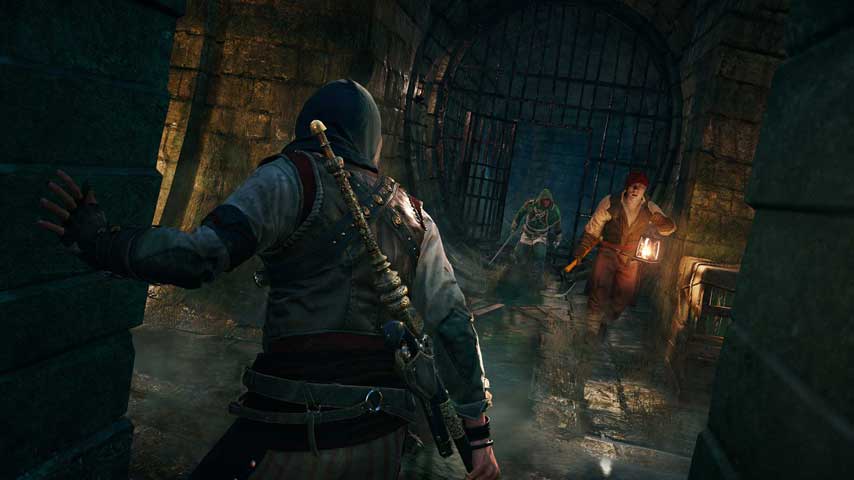
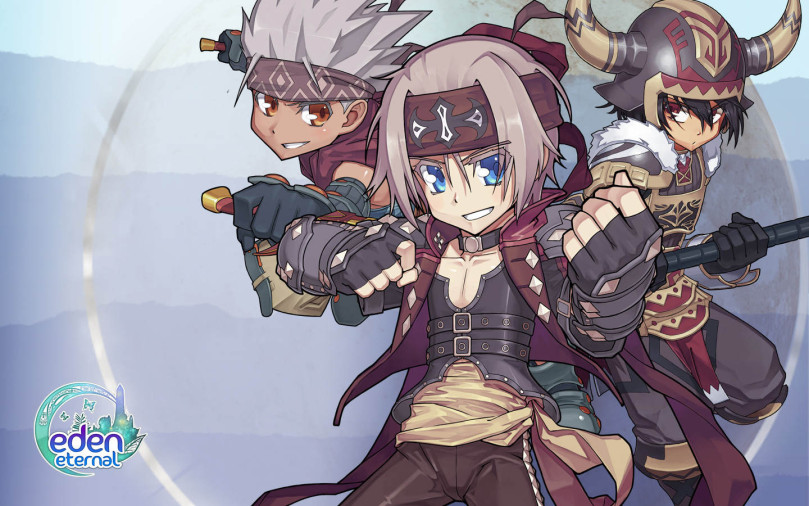

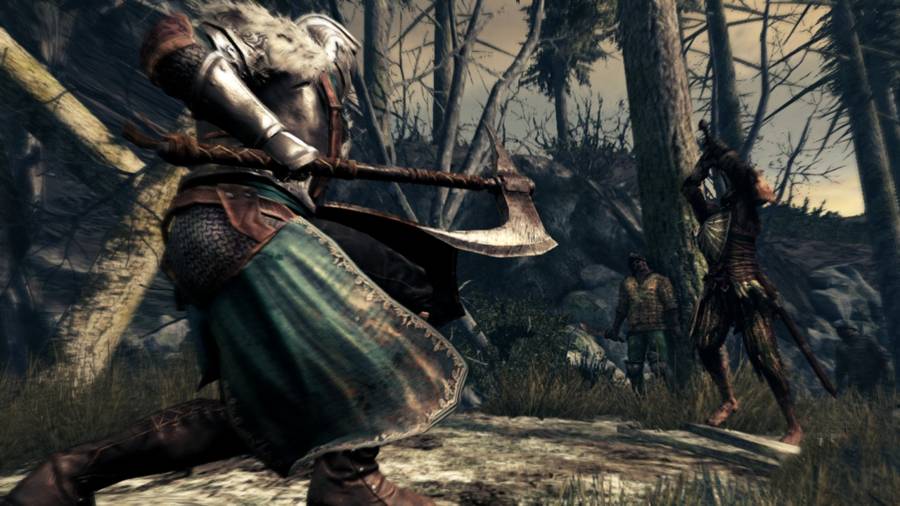
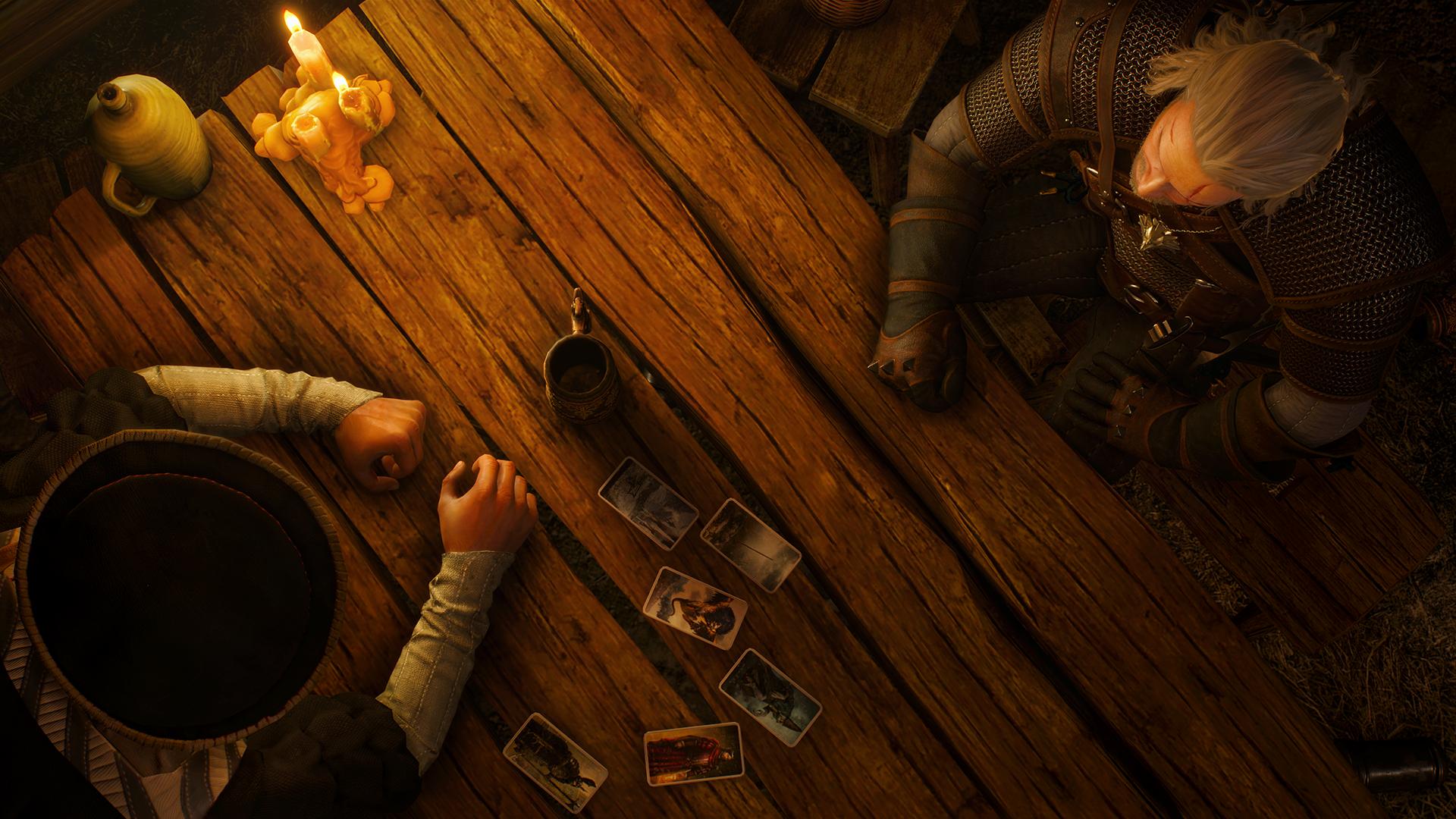 The Witcher 3 guide: how to kick ass at Gwent
The Witcher 3 guide: how to kick ass at Gwent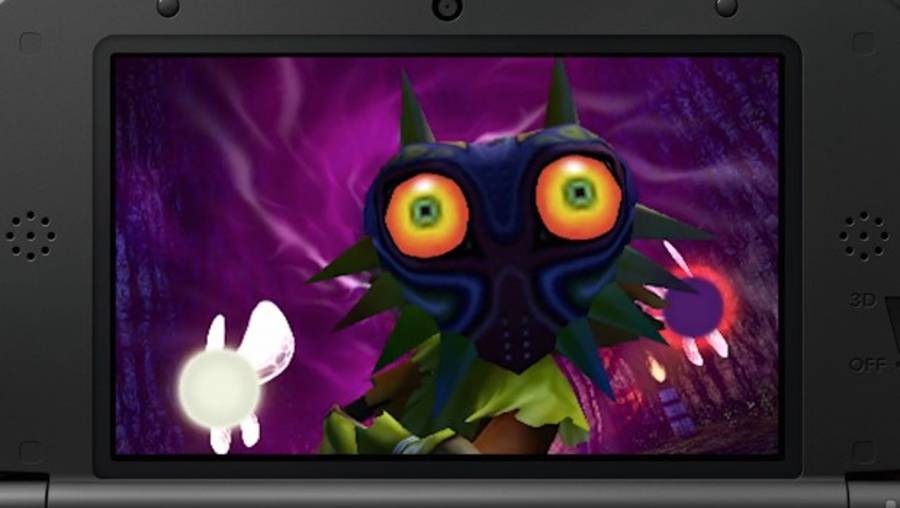 The Legend Of Zelda Majora's Mask 3D: Finding The Goron Mask
The Legend Of Zelda Majora's Mask 3D: Finding The Goron Mask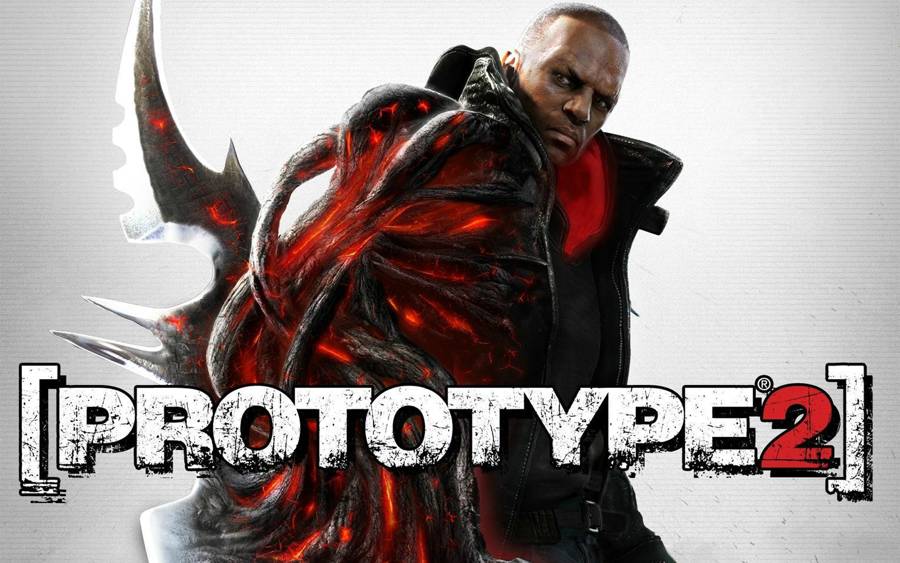 Prototype 2 Radnet Aerial Assualt Event Walkthrough
Prototype 2 Radnet Aerial Assualt Event Walkthrough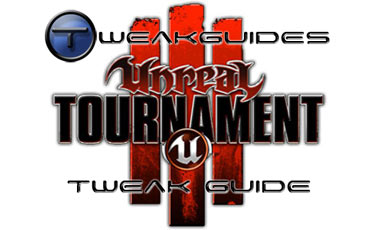 Unreal Tournament 3 Tweak Guide
Unreal Tournament 3 Tweak Guide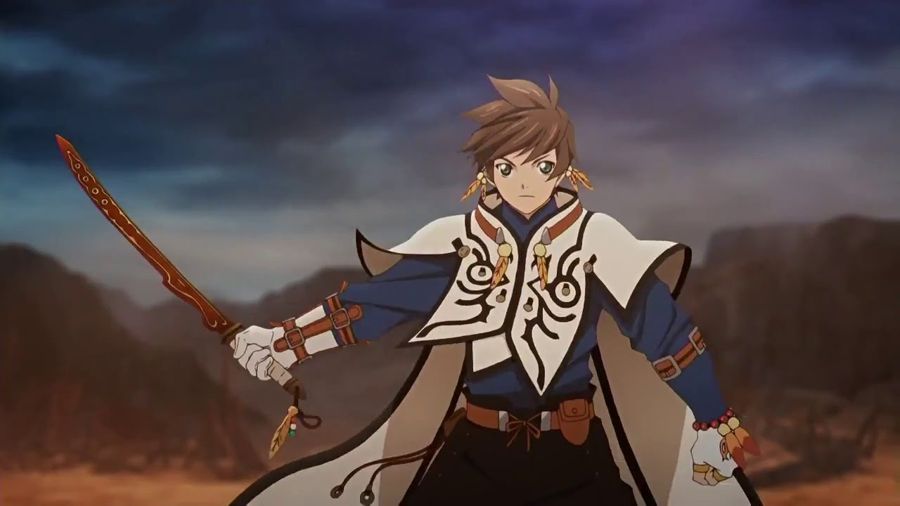 How To Access Your DLC Items In Tales Of Zestiria
How To Access Your DLC Items In Tales Of Zestiria